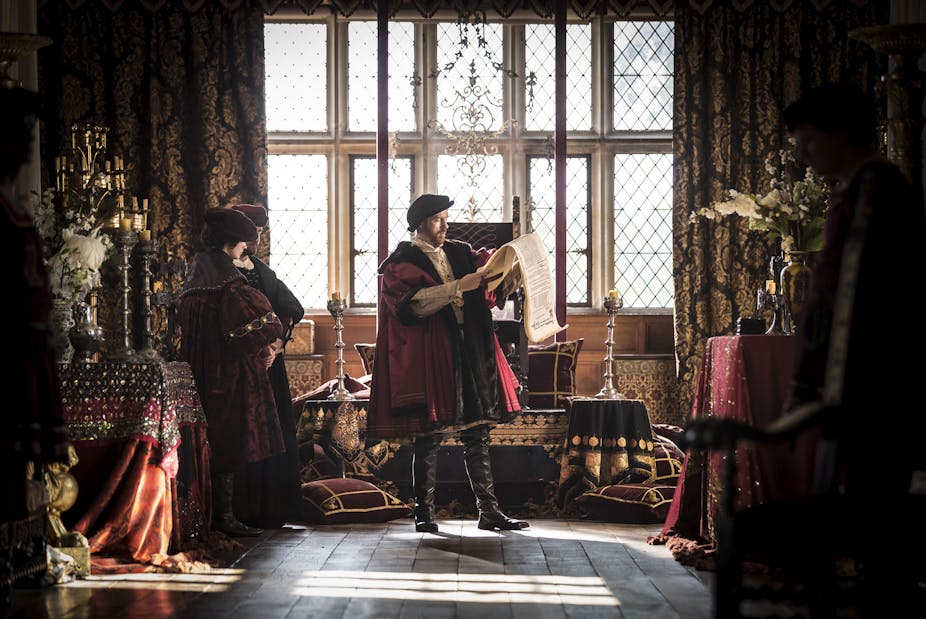It is 1529. Cardinal Wolsey leaves his palace at York Place, giving way to the triumphant Anne Boleyn, who holds court in the long gallery. But this York Place is not the princely residence of the Archbishops of York in London (Whitehall, between the Banqueting House and the River Thames), which burnt down in January 1698. As we sit in front of our televisions in 2015 watching the BBC television adaptation of Hilary Mantel’s Wolf Hall, we see an imagined York Place, filmed within the state rooms of Penshurst Place, Kent.
These are real spaces, resonant with the acoustic qualities of timber, stone and lime plaster. They offer the actors what no stage set can: a full sensory experience. But what do we as the audience get out of this substitution of one historic space for another? It is sometimes possible to spot disconcerting edits in films, as actors exit from one building into the courtyard of an unrelated place. Does it matter that architecture is cut and pasted to suit the production needs of filming? Using historic settings might signal a dramatic quest for authenticity, but there is a difference between being genuinely historic and being authentic.

A modern audience
The audience of 2015 is, after all, an audience of consumers. We consume media images with a degree of understanding about the gap between the final airbrushed edit and the mundane original. We are familiar with brands and with the process of branding that turn objects and people into desirable products.
The concept of authenticity is woven into business and advertising: brands promise individual self-fulfilment if we buy them, allowing us to express our authentic selves. We consume the historic settings presented on screen similarly; our perception that we are being offered genuine historic settings for a historical drama contributes materially to our enjoyment of the resulting production. A real Penshurst Place that is not York Place needs to be understood as both a genuine thing, in being a real building, and an authentic experience, in contributing to the value we get from the dramatic experience.
In business, authenticity is not something fixed or “real”, but rather a form of expression, whether of a style of leadership or as the values behind a brand. The term authentic in this context carries a very fluid interpretation: authenticity is created by doing something that provides an experience.
This is rather different from the definition of authentic most commonly applied to works of art, in the sense of being genuine – not faked or altered. There is a second and equally important definition of authentic, used by philosophers and adopted by business thinkers, and that refers to the expressive qualities within art that appeal to our senses.
When historic houses are used as stage sets, they are genuinely historic. But they are also used to express a set of values about the past that the drama depicts, values that are shaped by the creators of the drama.
Sense of a building
Penshurst Place, a beautiful medieval house with Tudor and Jacobean additions, is shown in its stage set role with its historic interiors dressed with rich textiles of the 16th century. The long gallery wasn’t built until 70 years after the period depicted in Wolf Hall, but this does not detract from its evocative appeal.
Getting this quality right is a challenge for location scouts and directors: the success of Castle Howard, a great Yorkshire country house used for the 1980s TV adaptation of Brideshead Revisited is the classic point of reference, where a house became a character in the drama. More commonly, historic locations are reassembled on screen to represent an imagined single place, but if the parts don’t feel right, the whole will lose its expressive authenticity.
Understanding authenticity as an experience also explains how historic settings are used to send signals about status and behaviour for the characters. Multiple Jane Austen adaptations offer us several ways of “seeing” how the Bennett family live, for example.
And Jane Campion’s Bright Star, the biographical film about the relationship between John Keats and Fanny Brawne, rejects Keats’s surviving house (a small white Regency villa) in favour of an older, more architecturally formal house to represent their shared home. This choice has a strong aesthetic role in heightening the contrast between the formal qualities of the architecture and the informality or rejection of convention expressed by the inhabitants.
Mike Leigh’s Mr Turner, on the other hand, prioritises using “complete” houses, allowing actors to move directly from entrances to interiors, which is the product of his improvisation technique.
All these examples show that historic buildings in TV may not be genuine. But they can still preserve a sense of the authentic: we just know it when we see it.

